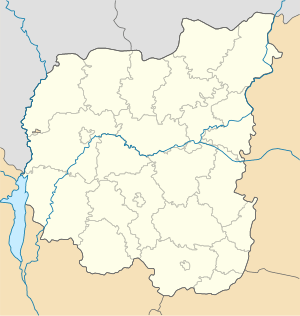Sosnytsia
Sosnytsia (Ukrainian: Сocниця) is an urban-type settlement and administrative center of Sosnytsia Raion (district) of Chernihiv Oblast (province) in north-central Ukraine. It is located on the west bank of the Ubid River, a tributary of the Desna river, some 90 km (56 mi) from Chernihiv, the oblast center. Population: 6,887 (2019 est.)[1]
Sosnytsia Сocниця | |
|---|---|
Town | |
_(1782).gif) Coat of arms | |
 Sosnytsia Location of Sosnytsia | |
| Coordinates: 51°31′52″N 32°29′59″E | |
| Country | Ukraine |
| Oblast | Chernihiv Oblast |
| Raion | Sosnytsia Raion |
| Area | |
| • Total | 8.97 km2 (3.46 sq mi) |
| Population (2019) | |
| • Total | 6,887 |
| • Density | 770/km2 (2,000/sq mi) |
| Area code(s) | +380 4655 |
Sosnytsia was the birthplace of Alexander Dovzhenko, a prominent Ukrainian filmmaker; his original house has been preserved as a museum in Sosnytsia dedicated to his life and work.
History
The name Sosnytsia derives from the same Slavic root as that of the Pine tree (in Ukrainian: Сocнa), and the area was most likely named as such because the plentiful pine forests which have populated the area for ages. The name was first recorded in the Hypatian Codex, where a chronicle from the year 1234 mentions that Danylo of Halych, while assisting the Kievan Grand Princes in their battle with Michael of Chernigov, had liberated several towns, including Sosnytsia.
The area had clearly been settled much earlier, as archeological remains from Neolithic, Bronze Age, and Scythian settlements have been found in the area, as well as Roman coinage. Settlements from the age of Kievan Rus' in the area have yielded impressive examples of skilled metalwork, in addition to evidence of a developed agricultural society, capable of producing its own livestock. These settlements were sacked along with Chernihiv in 1239 by the hordes of Batu Khan.
The area was resettled in 1370 during the reign of the Grand Duchy of Lithuania, and after a military conflict, it was ceded to Muscovite Russia in 1503. The Polish-Lithuanian Commonwealth reclaimed the area in 1618, and in 1634 built a fortress and established the city of Boplana in the area. Karpo Skydan raised a peasant rebellion against the Polish nobles in 1637, and by 1648 the area was taken by the Cossacks in their rebellion for self-rule. It transferred again to Polish rule after the Battle of Berestechko in 1651 as part of the Treaty of Bila Tserkva. This was shortly reversed in the aftermath of the Treaty of Pereyaslav, when Russia grew to encompass its eventual empire.
References
- "Чисельність наявного населення України (Actual population of Ukraine)" (PDF) (in Ukrainian). State Statistics Service of Ukraine. Retrieved 23 May 2020.
External links
- Наша Сосниця - website about Sosnytsya
- (in Ukrainian) (1972) Історіа міст і сіл Української CCP - Чернігівська область (History of Towns and Villages of the Ukrainian SSR - Chernihiv Oblast), Kiev.
- (in English) Sosnytsia in the Encyclopedia of Ukraine
- The murder of the Jews of Sosnytsia during World War II, at Yad Vashem website.